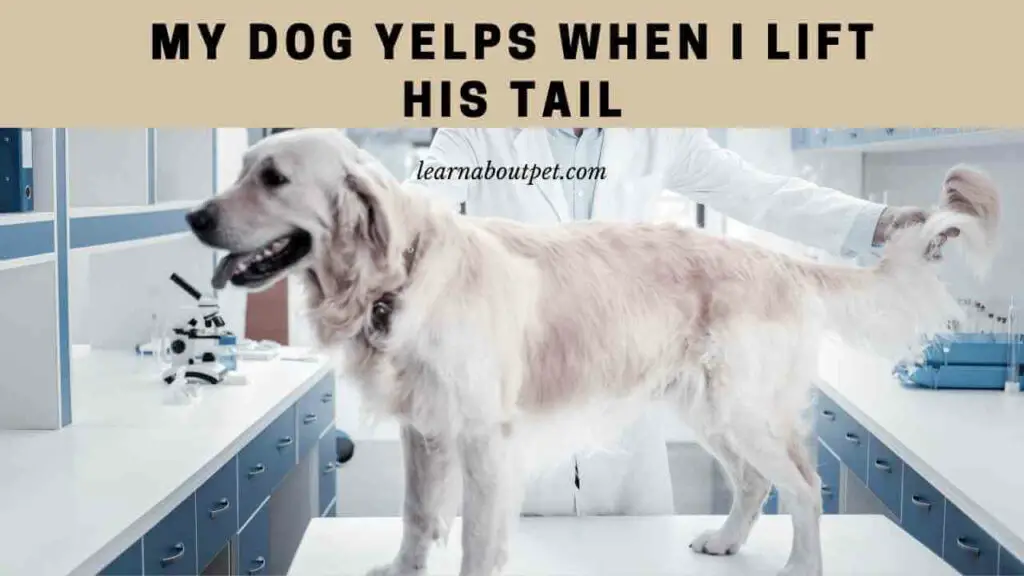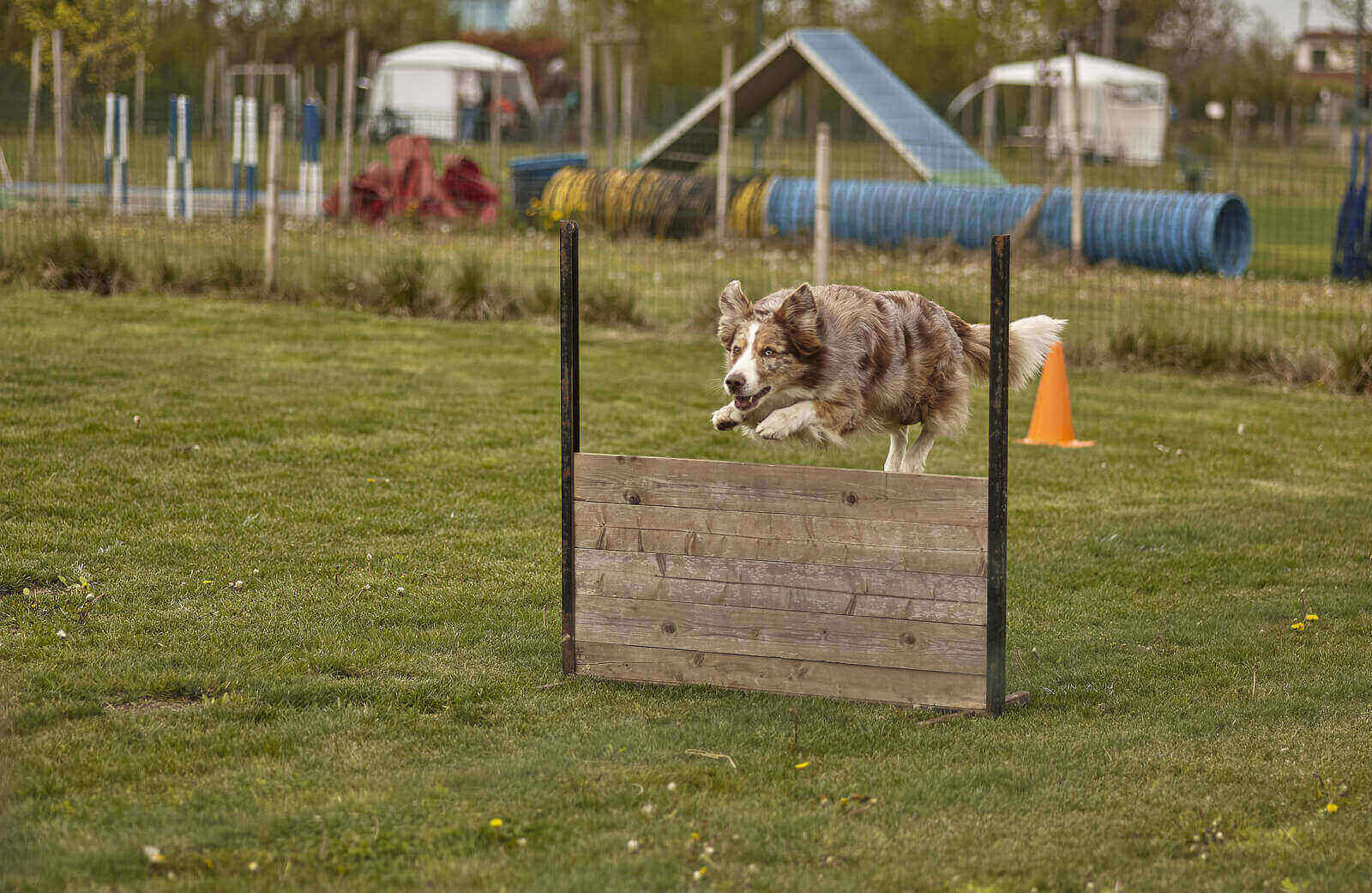A situation where your dog yelps when you lift his tail can cause you a great deal of concern. You will definitely want to know why the dog is yelping whenever you lift his tail. You will also want to know if there is anything you can do about this situation. Read on, for answers.
What does it mean if my dog yelps when I lift his tail? The dog may be suffering from limber tail syndrome. Or there may be injuries in the dog’s tail: anything from skin abrasions to muscle sprains and onto (tail) bone fractures. The dog could also be having anal gland impaction issues. Or the yelping could be due to emotional reasons.
Some of the issues that may cause a dog to yelp when his tail is lifted may resolve by themselves. Others may require home treatment. Others still may require veterinary attention.

What Does A Dog Yelp Sound Like?
Before proceeding to explore further on what it means if my dog yelps when I lift his tail, it is important to first understand what a dog’s yelp sounds like. The objective is to ensure that we don’t mistake other dog sounds for yelps.
So, indeed, what does a dog yelp sound like? A dog yelp is a sharp sound, something akin to a squeak or a squeal. Also known as a ‘whimper’ it is an unmistakably complaining/protesting sound.
What Does It Mean When A Dog Yelps?
In most cases, when a dog yelps, it means that it is experiencing pain or some other form of unbearable discomfort.
Therefore if my dog yelps when I lift his tail, the inference would be that he is in some sort of pain. Or, at the very least, it would mean that the dog is experiencing some discomfort from the tail lifting.
At this point, one may then ask, what does it mean when a dog yelps for no reason? And the answer would be that a dog is unlikely to yelp for no reason. In most cases, you find that there is an underlying reason – only that you are unable to figure it out.
All in all, when a dog yelps, it implies that he is in pain or experiencing some sort of great discomfort.
It is then upon you to check the circumstances, and try to figure out what exactly may be causing the dog pain or discomfort.
Why Does My Dog Yelp When I Lift His Tail?
If my dog yelps when I lift his tail, one possibility is that the tail has some injuries. The injuries may be superficial: for instance, skin scrapes or abrasions.
But the injuries could also be deeper: for instance muscle sprains, nerve damage or tail bone fractures. The tail could even be broken.
It could also be that the dog is suffering from limber tail. If my dog wont let me lift his tail, and he has previously taken part in very strenuous activity (or has been exposed to very cold weather), this is one of the possibilities I would look into. Limber tail is also known as ‘cold tail’.
Yet another scenario may be where the dog has some emotional issues that make it uncomfortable for him to have his tail lifted. These may be on account of previous trauma.
Or they may be on account of the dog being currently under stressful or anxiety-inducing conditions.
There is also the possibility of the yelping being due to the dog suffering from anal gland issues. For instance, when there is irritation or impaction in anal glands, the pain tends to spread to the base of the tail. This can make tail lifting very uncomfortable for the dog.
Thus, when trying to figure out why is my dog holding her tail down, once possibility I would consider is that of it being due to anal gland issues.
Whatever the underlying cause, when a dog yelps when you lift its tail, the inference is that there is some pain/discomfort somewhere. It is on account of that pain/discomfort that the dog is yelping when you lift its tail.
Does A Dog’s Tail Have Nerves?
In trying to figure out why my dog yelps when I lift his tail, it may be relevant to establish whether the dog’s tail has nerves.
If there are nerves in the dog’s tail, it would mean that the dog is capable of having sensations of pain there. And this can go a long way in explaining the yelping.
So, does a dog’s tail have nerves? The answer is ‘yes’. A dog’s tail does have nerves. In fact, a dog’s tail has a high level of innervation. This is what makes the tail very sensitive.
That is also why most dogs may be uncomfortable with petting on the tail (yet they are comfortable with petting elsewhere).
Does A Dog’s Tail Have Bones?
Further, in trying to figure out why my dog yelps when I lift his tail, it may be relevant to establish whether there are bones in the dog’s tail. If there are bones – which are prone to fracturing or breaking – then this may explain the yelping.
So, indeed, does a dog’s tail have bones? The answer is ‘yes’. A dog’s tail is in fact mostly a bony structure. It is made up of small bones, that are quite delicate, and which may fracture or even break with ease.
This therefore means if my dog yelps when I lift his tail, it may be on account of fractures in the tail bones. Or it may be that the bones in the tail are actually broken.
Does A Dog’s Tail Have Muscles?
One more thing that may be necessary to establish, while trying to figure out why my dog yelps when I lift his tail, is whether the dog’s tail has muscles.
Should there be muscles in the dog’s tail, those would be prone to spraining. And the muscle spraining would (in some cases) explain the dog yelps.
So, does a dog’s tail have muscles? The answer is ‘yes’. A dog’s tail has muscles. It is these muscles that make it possible for the dog to move its tail upwards, downwards and sideways. It is these muscles that make it possible for the dog to wag its tail.
Now the muscles in the dog’s tail are prone to spraining. This can be painful. And when it happens, it can cause a dog to yelp whenever its tail is lifted.
Why Is My Dog In Pain When I Lift His Pain?
If my dog yelps when I lift his tail, the inference is that he is in pain. This leads to another question on exactly why is my dog in pain when I lift his tail?
The most likely reason is that the tail is injured. Perhaps there is a fracture in one (or several) of the small bones that make up the dog’s tail. Or perhaps the bones that make up the dog’s tail are broken.
It could also be that there is spraining in the muscles that support the dog’s tail. So on account of this spraining, the dog experiences great pain when you lift his tail.
At yet another level, there could be superficial injuries on the dog’s tail that nonetheless cause some pain. These may be scrapes or abrasions. On account of these, the dog may be finding it rather painful when you lift his tail.
Besides tail injuries, another area to look into, if a dog is in pain when you lift his tail, is that of anal gland issues. Dog’s anal glands are prone to irritation and impaction. This causes pain, which often spreads onto the tail.
Therefore if a dog has impaction or irritation in its anal glands, the end result can be pain when you lift its tail up.
How Do You Tell If A Dog’s Tail Is Sprained?
One sign that a dog’s tail is sprained is where it hangs in a limb manner. This is different from the normal tail tucking, which dogs exhibit when they have fear. The limp tail in this case doesn’t seem to have any life. It just hangs straight down.
At this point, one may ask, do dogs tuck their tail when they are in pain? And the answer would be that whereas dogs have a tendency to keep their tails down when they are in pain, it is usually not ‘tucking’ in the strictest sense of the word.
Where dogs genuinely tuck their tails, it is usually on account of fear.
Thus if you have been trying to figure out why is my dog holding her tail down, this (spraining) may be the reason.
Besides the dog’s tail hanging in a limb manner, spraining also causes a great deal of pain. This makes the dog generally restless and unhappy. Thus, even in a situation where my dog cries when I lift him up, this may be the underlying reason.
The pain will of course also make it very uncomfortable for the dog to have its tail touched or lifted. Consequently, if my dog yelps when I lift his tail, this would definitely be one of the possibilities to consider.
The underlying scenario may be one where the dog sprained tail from wagging too hard.
All in all, the spraining almost always manifests through pain, and the tail hanging in a lifeless manner.

How Do You Tell If A Dog’s Tail Has Abrasions?
In most cases, you only need to inspect the dog’s tail carefully, to see if there are any abrasions on it. The abrasions will typically manifest as wounds or cuts. Some may be deep while others may be superficial.
If my dog yelps when I lift his tail, and there are open cuts/wounds on the tail, then the yelping/pain may be due to those abrasions.
The abrasions may also be responsible for a situation where a dog won’t let you lift its tail. Thus in trying to figure out why won’t my dog let me lift his tail, this possibility (of there being abrasions on the tail) is one worth considering.
How Do I Know If My Dog Has Limber Tail?
While answering the question on why my dog yelps when I lift his tail, we pointed out that one of the possibilities is that of it being due to limber tail. This then leads to an interesting question – on how one can tell for sure if their dog has limber tail.
As it turns out, there are several ways in which you can tell if your do has limber tail syndrome.
Firstly, a dog with limber tail syndrome has a tail that is either completely limb or partially limb. So you find that the tail just hangs on the dog in a lifeless manner.
Secondly, a dog with the limber tail syndrome has a tail that doesn’t wag. So you find that a dog that was previously always wagging its tail is completely unable to do so. This may be limber tail syndrome manifesting.
Thirdly, a dog with limber tail syndrome will experience pain when you lift its tail. In fact, it gets to a point where the dog yelps when you just touch its tail (or even when you seem to be about to touch its tail).
If you encounter these symptoms, you may need to start to figure out how to treat limp tail in dogs. But you need to note that there are some seemingly severe cases in which limber tail treatment at home may not be very appropriate.
How Do You Tell If Your Dog’s Anal Glands Are Irritated?
The classic manifestations of dog anal gland irritation include excessive scooting, licking, swelling and painful defecation.
The anal gland irritation may also cause the dog’s tail base to be painful. Thus if you have a dog tail sore at base, this could be the reason.
Further, the anal gland irritation often causes the dog to engage in excessive tail chasing behavior. This then leads to tail muscle spraining. The end result is a situation where the dog’s tail becomes painful.
Therefore if my dog yelps when I lift his tail, it could be due to anal gland irritation. It may be as a direct result of the soreness at the tail’s base.
Or it may be as a result of the spraining that arises from the dog excessively chasing its tail – which is in turn as a result of the anal gland irritation.
My Dog Yelps When I Lift His Tail – What Are The Core Possible Reasons?
Where my dog yelps when I lift his tail, the core possibilities are that the tail is injured, the dog has limber tail syndrome, the dog has anal gland issues or the dog is yelping due to emotional issues.
The injuries may be in the form of tail abrasions, tail lacerations, tail bone fractures, tail muscle sprains or tail nerve damage.
The anal gland issues on the other hand affect the area close to the base of the dog’s tail. This pain then affects the whole tail – making it uncomfortable for the dog to have it lifted.
The emotional issues may be things like fear, stress and anxiety, as well as past trauma – which make it uncomfortable for the dog to have its tail lifted.
Thus in trying to understand why won’t my dog let me lift his tail, these would be the key possibilities to consider.
My Dog Yelps When I Lift His Tail – What To Do?
The first step is to try to understand what is causing the pain. When a dog yelps, it means that the dog is experiencing pain. Therefore if a dog yelps when you lift its tail, this means that lifting the tail is causing it pain. Now try to understand the reason behind the pain.
Where it is due to superficial injuries in the tail (things like abrasion and lacerations), all you may need to do is clean the wounds.
Then apply antibiotic solutions, such as Neosporin, to prevent infection. You could also make use of pain medications, to lessen the dog’s agony. After that, allow time to heal.
Where the abrasion or lacerations are deep, maybe requiring stitches, take the dog to the vet.
In cases where the pain seems to be due to things like bone fractures or nerve damage, it is best to seek a vet’s treatment.
Where the pain seems to be due to limber tail syndrome, you can give it time to resolve. You can, in the meantime, use anti-inflammation medication.
But where the symptoms seem to be particularly bad, consult a vet. What may be playing out may be something more serious than limber tail.
In cases where the pain seems to be due to emotional issues, you will need to build trust with the dog gradually. If there are other symptoms of emotional trauma, and the dog is regressing in emotional development terms, it may be best to consult a dog behaviorist.
Where the pain seems to be due to anal gland impaction, you may need to have the dog’s anal glands drained. This can be done by a dog groomer or, even better, by a vet.
Final Verdict – My Dog Yelps When I Lift His Tail
Where my dog yelps when I lift his tail, the inference is that the dog is experiencing pain when his tail is lifted. The pain may be due to injuries in the tail. It may also be due to limber tail syndrome, due to emotional issues or due to anal glands impaction/irritation.
Once you identify the reason why the dog is experiencing pain when you lift his tail, you can proceed to take remedial measures.
In some cases, like where the issue is due to tail skin abrasions or lacerations or uncomplicated limber tail syndrome, home treatment may suffice. In fact, the dog may just get well on its own, given time.

But where the issues seem to be more serious – like where it is due to tail nerve damage or tail bone fractures – it is best to take the dog to a vet’s clinic for treatment.
As a pet lover, make sure to learn about pet more and give your pet dog a good and comfortable life!

Welcome to Learn About Pet. My name is Rajkumar Ravichandran and I love all pets, travel, and amazing food. I write about my passion and personal experience caring for multiple pets in this blog! ❤️
Post Disclaimer
DISCLAIMER: THIS BLOG OR WEBSITE, "Learn About Pet", DOES NOT PROVIDE YOU WITH MEDICAL ADVICE AND IS NOT A SUBSTITUTE FOR MEDICAL ADVICE. ALWAYS GET IN TOUCH WITH YOUR PERSONAL VETERINARIAN AND USE INFORMATION HERE AS GENERAL ADVICE.
The information, including but not limited to, text, graphics, images and other material contained on this website are for informational purposes only. No material on this site is intended to be a substitute for professional veterinary advice, food recommendation, diagnosis, or treatment. Always seek the advice of your veterinarian or other qualified health care provider with any questions you may have regarding a medical condition or for pet food related questions.







